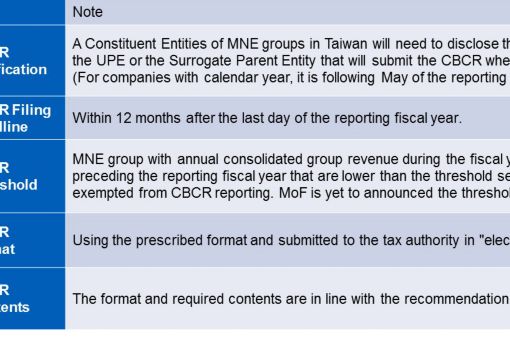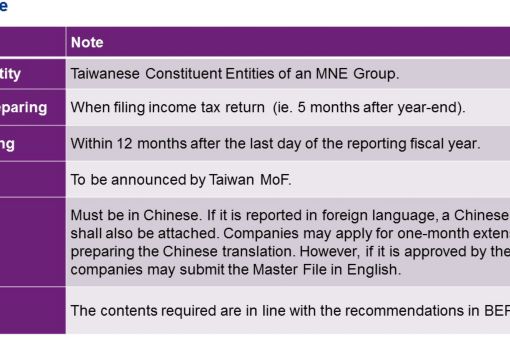e-Tax alert 96 - Taiwan released amended transfer pricing rules for CBC reporting and master file effective for 2017
e-Tax alert 96 - Taiwan released amended TP rules
Taiwan Ministry of Finance announced the draft amendments to “Regulations Governing Assessment of Profit-Seeking Enterprise Income Tax on Non-Arm's-Length Transfer Pricing” ("TP Assessment Rules") in response to the international trend of anti-tax avoidance and the enhancement of tax information transparency. The amended TP Assessment Rules had included the three-tier transfer pricing documentation as suggested by OECD under Base Erosion and Profit Shifting ("BEPS") Action 13 Report. It is expected the amended rules will apply to fiscal years on or after January 1, 2017
On July 27, 2017, Taiwan Ministry of Finance announced the draft amendments to “Regulations Governing Assessment of Profit-Seeking Enterprise Income Tax on Non-Arm's-Length Transfer Pricing” ("TP Assessment Rules") in response to the international trend of anti-tax avoidance and the enhancement of tax information transparency. The amended TP Assessment Rules had included the three-tier transfer pricing documentation as suggested by OECD under Base Erosion and Profit Shifting ("BEPS") Action 13 Report. It is expected the amended rules will apply to fiscal years on or after January 1, 2017.
The main amendments relevant to the three-tier transfer pricing documentation are:
- The main amendments relevant to the three-tier transfer pricing documentation are:
New County-by-Country Reporting ("CBCR") rules, include criteria for Reporting Entity, deadline, definition of constituent entities and contents of the report. (New Article 22-1) - New Master File (“MF”) rules, include criteria for Reporting Entity, deadline, and the contents of the report. (New Article 21-1)
- New CBCR disclosure requirement to disclose the information of the “Ultimate Parent Entity” of a multinational enterprise (MNE) and the “Surrogate Parent Entity” that files the CBCR. (Amended Article 21)
- Amended the requirements of the contents of Taiwan Transfer Pricing Report to reflect the suggestions made under BEPS Action 13 Report for Local File. (Amended Article 22)
The main content of the draft amended TP Assessment Rules are summarized as follows:
Country-by-Country Reporting
Company that needs to file CBCR to Taiwan Tax Authority
If the group’s annual consolidated group revenue exceed the threshold, the following entity is required to file CBCR with Taiwan tax authority.
- For Taiwanese MNE Group
If the Ultimate Parent Entity (UPE) of an MNE Group is Taiwanese entity, it should file CBCR.
- For Foreign MNE Group (with UPE outside of Taiwan)
For a Taiwanese entity of a foreign MNE group, the Taiwanese entity is required to file CBCR if one of conditions below is met:
- The UPE of the MNE Group is not obligated to file a CBCR in its jurisdiction of tax residence;
- The UPE of the MNE Group had filed a CBCR in its jurisdiction of tax residence, however such jurisdiction has not entered into any agreement with Taiwan for exchanging of CBCR before Taiwan CBCR filing deadline; or
- The UPE of the MNE Group had filed a CBCR in its jurisdiction of tax residence and such jurisdiction had entered into an agreement with Taiwan for exchanging of CBCR, however Taiwan tax authority was unable to obtain the CBCR based on the agreement.
If the Group has two or more members in Taiwan, it can designate one of the members to file the CBCR, and to notify the rest of the members in Taiwan as well as their governing Taiwanese tax offices.
If Surrogate Entity file CBCR, conditions that the Taiwanese Entity is exempted from filing CBCR
If the foreign Group appoints one of the members to act as surrogate to file the CBCR, and the Surrogate Entity meets the following criteria, the Taiwanese entity is not required to file CBCR to Taiwanese tax authority:
- The jurisdiction of tax residence of the Surrogate Entity requires to file CBCR.
- The jurisdiction of tax residence of the Surrogate Entity had entered into an agreement with Taiwan for exchanging of CBCR and Taiwan tax authority can actually obtain the CBCR.
- Taiwanese entity has disclosed the information of UPE and Surrogate Entity when filing the income tax return according to Article 21 .
KPMG Observations
MNE Groups need to determine which member is responsible for filing the CBCR. Especially for foreign companies, they need to understand whether there is a tax treaty or a tax information exchange agreement (TIEA) between Taiwan and the jurisdiction which the Group file for CBCR. The foreign subsidiaries/branch in Taiwan then can decide if it needs to file CBCR with Taiwan tax authorities.

KPMG Observation
It is expected that the threshold of CBCR will follow the OECD suggested EUR 750 million and translated into NTD. The requirements of the contents and covered entities are consistent with the OECD suggestion and international trend. The above requirements will be presented in tabular form and submit electronically. It is suggested companies which meet the threshold to start the preparation for CBCR as soon as possible.

KPMG Observation
In Taiwan, companies that meet the threshold are required to submit a copy of Master File needs to be submitted. The Chinese translation is required if it is in foreign languages. The MoF will announce the threshold later.Master File is prepared from the group’s perspective and involves complex transfer pricing issues, such as intangible assets and value chains. The MNE groups should confirm whether the information disclosed in the Master File is consistent with its transfer pricing reports and the explanation provided to tax authorities during the audit. The Chinese translation is required if it is in foreign language.
Local File
In response to the suggested content for local file by OECD under Action Plan 13, the draft amendment to "TP Assessment Rules" require the additional following content:
Company Overview
A detailed description of the business strategy pursued by the local entity, analysis of industry and economic situation, key competitors, as well as whether the local entity has been involved in or affected by business restructurings or intangibles transfers in the present or immediate past year.
Group Organization and Management Structure
A description of the management structure of the local entity, a local organization chart, and a description of the individuals to whom local management reports and the country(ies) in which such individuals maintain their principal offices.
Summary Information of Controlled transactions
To more clearly disclose the necessary information
- A description of the major controlled transactions and relevant background.
- Participants that involved in each type of controlled transactions and their relationship with each other.
- List the controlled transaction amount of each type of transaction by the countries and regions of the counter party.
- Copies of material intercompany agreements signed by the local entity.
Analysis of Controlled transactions
- A detailed function and risk analysis of the participants of the controlled transactions, include the difference comparison between current year and last year.
- A copy of existing unilateral and APAs and other tax rulings to which the local tax jurisdiction is not a party and which are related to controlled transactions described above.
Penalty
If the company fail to comply the filing requirements upon tax authority’s request. The above three types for reports, it will be subject to a penalty ranging from NTD 3,000 to NTD 30,000, under Article 46 of the Tax Collection Act.
KPMG Observation
The draft amendments are in line with international trends and public expectations. The newly added report content is consistent with the three-tier transfer pricing documentation suggested by OECD under BEPS Action Plan 13. However, the specific impact to companies is yet to be determined, depending on the thresholds which will be announced by the Ministry of Finance later.
In the future, the tax information of MNEs will be more transparent among tax authorities in different jurisdictions. Tax authorities will be able to better understand and monitor the Group’s holding structure, profit allocation, operation substance and status of tax paid. This not only increase the Group's transfer pricing audit risk, but also enhance tax officers’ ability to implement other anti-avoidance measures, such as Controlled Foreign Companies (CFC) and Place of Effective Management (PEM) terms.
The new transfer pricing documentation requirements are expected to be effective in the 2017 fiscal year. Companies should immediately assess the potential impact and form strategies to response. Suggested actions are as follows:

e-Tax alert
© 2025 KPMG, a Taiwan partnership and a member firm of the KPMG global organization of independent member firms affiliated with KPMG International Limited, a private English company limited by guarantee. All rights reserved.
For more detail about the structure of the KPMG global organization please visit https://kpmg.com/governance.
上列組織及本文內任何文字不應被解讀或視為上列組織之間有任何母子公司關係,仲介關係,合夥關係,或合營關係。 上述成員機構皆無權限(無論係實際權限,表面權限,默示權限,或任何其他種類之權限)以任何形式約束或使得 KPMG International 或任何上述之成員機構負有任何法律義務。 關於此文內所有資訊皆屬一般通用之性質,且並無意影射任何特定個人或法人之情況。即使我們致力於即時提供精確之資訊,但不保證各位獲得此份資訊時內容準確無誤,亦不保證資訊能精準適用未來之情況。任何人皆不得在未獲得個案專業審視下所產出之專業建議前應用該資訊。